Low Flying Hot Air Balloons
Two of the most common questions we see on social media are “why are the hot air balloons flying so low” and “that hot air balloon flew right above my house”. Most folks are just curious because they have questions about safety, and others have questions about legality. We are going to walk you through why hot air balloons often fly low, give you a really good understanding on the methods balloon pilots use to land, and the legalities around flying close to the ground.
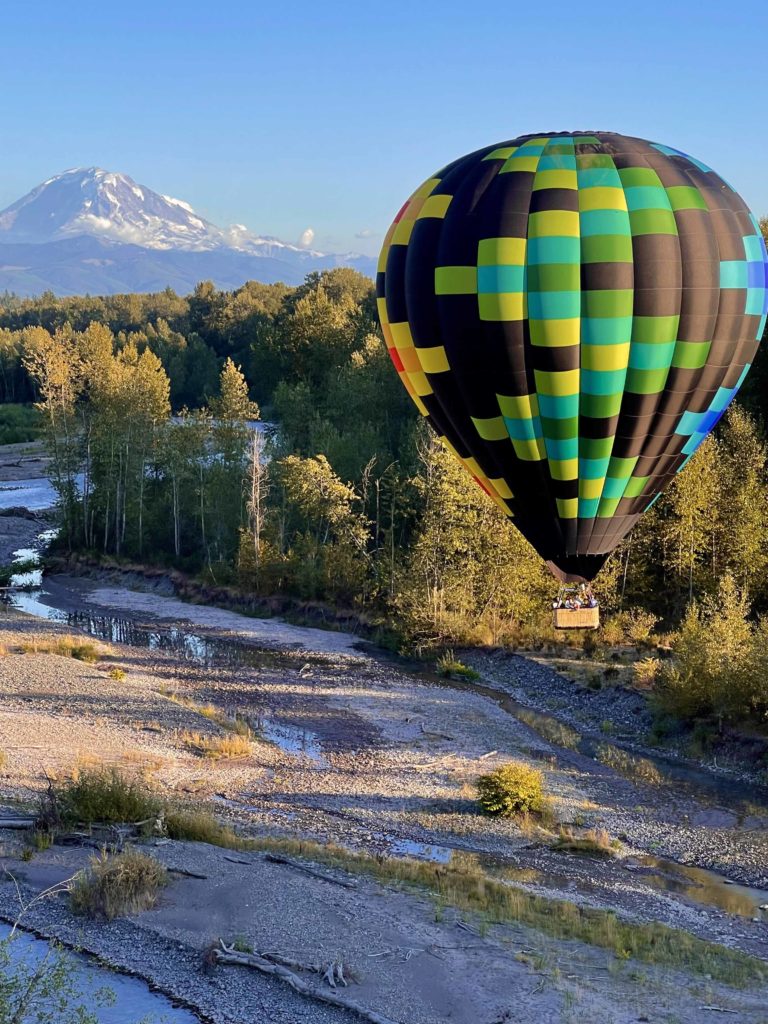
Landing a hot air balloon can be tricky and is both an art and a science. There are many things that pilots must take into account when landing, such as the wind direction, the weight of the balloon, and the height of obstacles around the landing site. Landing a hot air balloon is often compared to landing a 747 on very shot runway–it’s a complex process that takes a lot of skill and experience.
Curious why hot air balloons fly low? Typically if a hot air balloon is flying below 500 ft they are in the process of taking off or in the process of landing. Let’s chat about the legalities of flying at different heights for all aircraft.
FAA Minimum Altitudes For All Aircraft
The FAA (Federal Aviation Administration) has the same minimum altitudes for all types of aircraft. This includes fixed-wing aircraft, ultralight aircraft, hot air balloons, and anything else that can fly! If you are interested in reading the advisory circular from the FAA regarding hot air balloons you can find the link here https://www.faa.gov/documentLibrary/media/Advisory_Circular/ac91-71.pdf
91.119 (Rules For Low Flying Hot Air Balloons)
91.119 in FarAim walks us through this. We’ll then apply this specifically to hot air balloons to give you an in-depth understanding.
Except when necessary for takeoff or landing (This is a key wording we’ll be chatting about), no person may operate an aircraft below the following altitudes:
(a) Anywhere. An altitude allowing, if a power unit fails, an emergency landing without undue hazard to persons or property on the surface.
(b) Over congested areas. Over any congested area of a city, town, or settlement, or over any open air assembly of persons, an altitude of 1,000 feet above the highest obstacle within a horizontal radius of 2,000 feet of the aircraft.
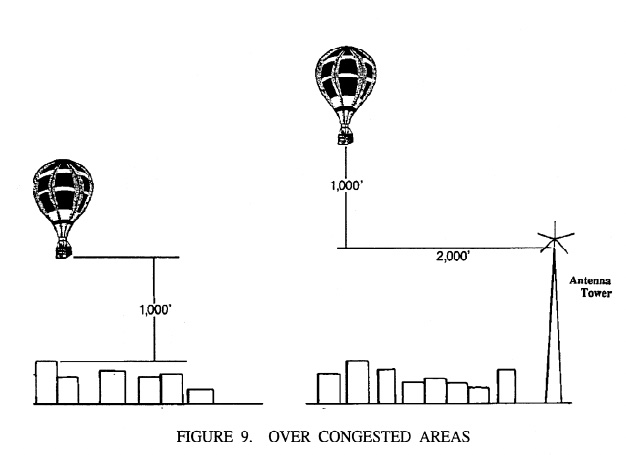
(c) Over other than congested areas. An altitude of 500 feet above the surface, except over open water or sparsely populated areas. In those cases, the aircraft may not be operated closer than 500 feet to any person, vessel, vehicle, or structure.
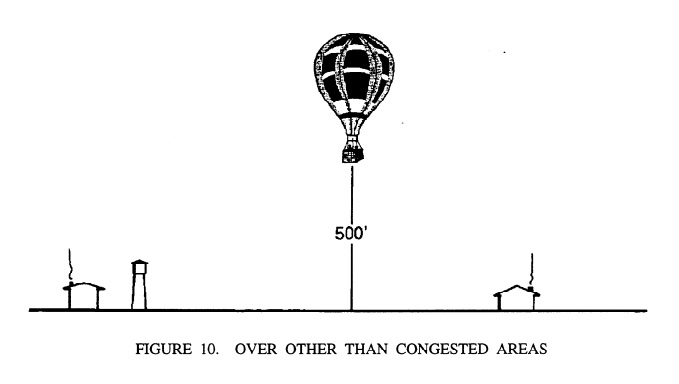
Let’s break down the exception to 91.119 “Except when necessary for takeoff or landing”. If you’ve ever been on an airplane flight, you’d know that it wouldn’t be very safe for an airplane to nose dive toward the ground and pull up at the last minute to land. Instead, pilots use a 3-degree glide path. The faster the speed the faster the descent rate. Hot air balloons typically fly in slow wind and typically land in wind less than 5kts. A 3-degree glide path at 5kts would mean the balloon would have a descent rate of 26.6 feet per minute. If you break that down by time, it would take a balloon descending from 1000 feet 38 minutes to reach the ground and land.
3-Degree Descent Rate
So why do people often see hot air balloons flying low? We’ll, a hot air balloon flight typically lasts around an hour. If it takes up to 38 minutes in a 3-degree descent to reach the ground, that can be a long period of time a balloon is flying low.
During that 3-degree descent, there may also be objects like trees, powerlines, buildings, and cell phone towers that require balloon pilots to ascend a few hundred feet. After ascending to a safe altitude the 3-degree descent rate starts from that new altitude. Many pilots prefer a steeper descent, however, the 3-degree glide path has been established as a standard for all aircraft over congested places.
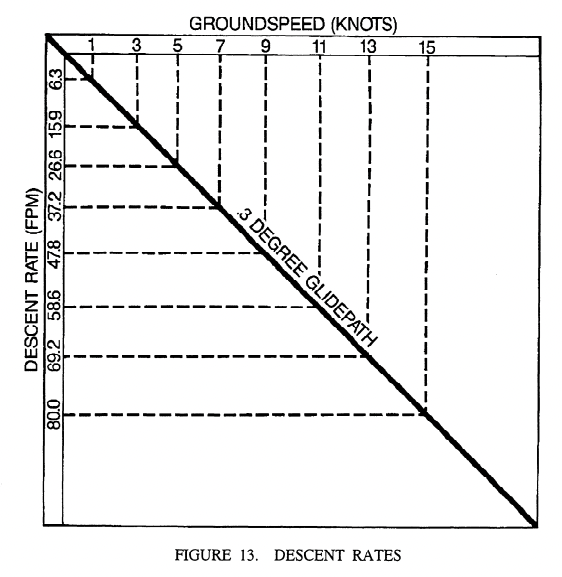
Stair Step Descent Method For Hot Air Balloons
When hot air balloons are at altitude, balloon pilots use a series of steep descent before starting their 3-degree landing procedure. This method is called the stair-step method. When possible, the stair-step method can be used to help hot air balloon pilots avoid long flight segments at low altitudes. This method also allows pilots to use the wind at different levels to navigate to a designated landing area. The stair-step approach involves different descent rates and lets pilots evaluate the wind direction and wind speed. To get a good idea of what the wind is doing beneath a balloon requires balloon pilots to drop a light object. Most hot air balloon pilots drop popcorn, Cheetos, blades of grass, strips of biodegradable paper, or small balloons. As pilots work down each step or are using a 3-degree glide path, it can often lead observers on the ground to assume that the pilot has discontinued their landing approach and are at a cruising altitude. The truth is that the pilot is using a specific wind at a specific altitude in order to land at a designated landing location or has transitioned to the 3-degree landing glide path.
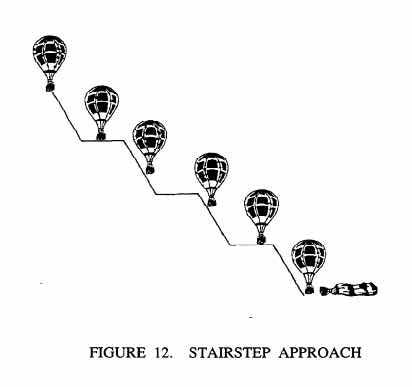
How Fast Can Balloons Ascend And Descend?
Another question folks ofter are curious about is how fast a hot air balloon can ascend or descend. There are two limitations. One limitation is based on the total weight of passengers in a hot air balloon, and the other is for safe operation by the hot air balloon manufacturer. Although the specific descent and ascent rates can be found in hot air balloon manuals, the general consensus is hot air balloons have a max safe ascent of 1000 feet per minute. Most hot air balloon pilots limit their ascents from 200-800 feet per minute. Descent rates are interesting. The hot air balloon envelope acts as a parachute and has a ton of drag. The maximum descent is based on the weight of passengers in the basket. A lightly loaded balloon may have a terminal descent rate of 750 feet per minute, whereas a heavily loaded larger balloon may reach up to 1200 feet per minute. The idea is to make sure the pilot has enough time to arrest the balloon with the propane burner before touching the ground.
Weather and Wind
Hot air balloon pilots typically have a goal in mind and a designated landing area they are trying to land at. As the FAA states, hot air balloons are non-steerable aircraft. Hot air balloons have no way of changing direction except for using winds at different heights or geological features impacting the direction of wind flow. Before a balloon flight is approached, aeronauts plot out their proposed flight path. Pilots use data from the national weather service, computer models, weather station data, and real-time weather to get a good idea of the upper-level wind direction and speed. There are conditions for ballooning that are good, conditions that are marginal, and poor flying conditions. Hot air balloons typically only fly in good wind conditions and never fly in or around adverse weather conditions. Although it is fine for hot air balloons to fly in strong winds aloft, it’s important for a safe landing to have calm winds on the surface.
The Winds Are Always Changing
Unfortunately, the wind constantly changes due to pressure systems, air temperature, heating, and cooling. Most of the winds that hot air balloons use below 3000 feet can only be discovered by releasing a helium balloon before the flight, sending up a drone to collect wind data, or dropping light items from altitude and watching them as they slowly descend. This is the art and science of steering a hot air balloon, and some are better at it than others.
Hot Air Balloon Flight Paths
Once the hot air balloon is in flight, the pilot will take mental notes at each altitude of the actual wind speed and direction at different altitudes. They essentially create a 3D wind map in their head. The balloon pilot then uses this knowledge to tack back and forth toward the place they intend to land. If the wind speed or direction of wind changes, the landing site will be reevaluated.
Selecting A Hot Air Balloon Landing Site
Landing a hot air balloon is very similar to a trip to purchase a dozen eggs at the grocery store. Most folks have a goal of getting a parking spot that is right in front of the entrance to the store. Unfortunately, it’s luck. It happens sometimes, but often you’ll drive around the parking lot to find the next best place. This is exactly what occurs in hot air ballooning. Pilots have a designated landing spot where they would like to end up at. Unfortunately, the wind direction changed due to something uncontrollable (the pressure, heat of the ambient air, or the geology). As you drive around the parking lot you get excited when you see an open space. Unfortunately, you discover that it is a handicap spot, and is illegal to park there. Hot air balloons can’t land anywhere they want. Unless it is an emergency, hot air balloons can’t land in the middle of the highway, on top of a building, in a body of water, or next to powerlines. As you continue your search for a parking spot, you find one! Unfortunately, one of the cars has done a terrible parking job and is too far over the line. Your car won’t fit. We have the same issue with hot air balloons. Hot air balloons are over 100ft tall and 60 feet wide. There needs to be ample room for the balloon to land and be deflated without it touching trees, signs, homes, or other sharp obstacles. Finally, you drive to the back of the parking lot and find a spot to park your car. The difference is hot air balloons really can’t turn and go up and down aisles looking for the best spot, they have to find an open spot in the lane they are in or park in the next plaza. The next plaza may be an odd place to park. That’s why you see hot air balloons landing in a variety of areas from parks, to culdesac’s, and grocery parking lots. The goal is always to land in a safe place away from obstacles, animals, and restricted areas.
Joining A Hot Air Balloon Chase
So the next time you see a hot air balloon landing or flying low for some period of time you’ll know why! Whether you are chasing balloons on the ground or partaking in a hot air balloon ride, being around hot air balloons is a memorable experience! You are always welcome to follow the ground crew chasing the balloons and ask questions. We only ask that you don’t follow the crew onto a property without their permission!
Want to book a hot air balloon ride yourself? You can do that right here with the top hot air balloon company in the NW, Seattle Ballooning. Fly with Seattle Ballooning directly in front of Mt. Rainier on a sunrise or sunset hot air balloon flight.
If you have other questions about ballooning techniques check out our other blog posts and FAQ’s below.
Learn about the history of ballooning. It all started with a chicken, a sheep, and a duck.
Have a safety concern about hot air balloons or want to learn about why hot air balloons are the safest form of all aircraft?
